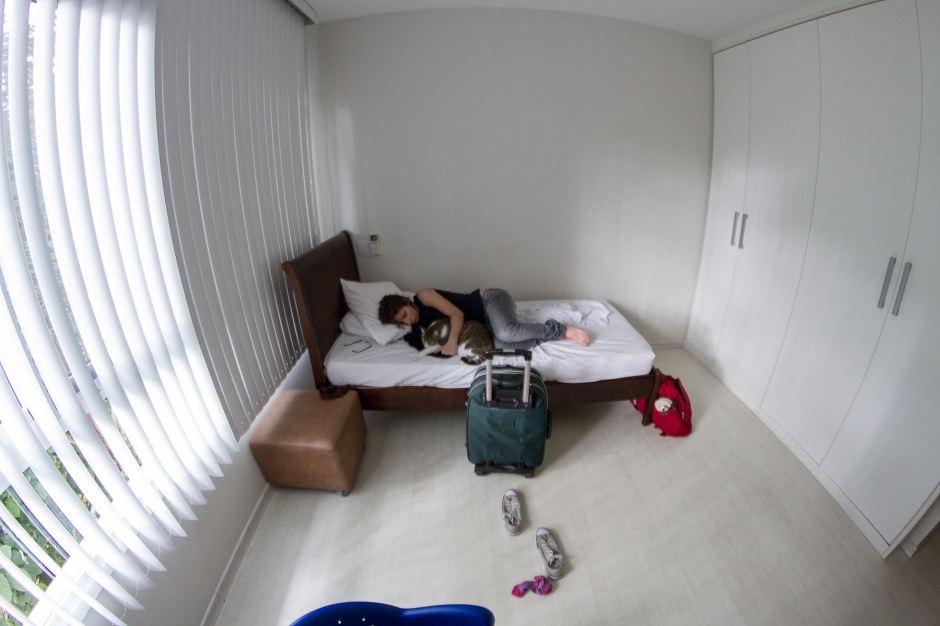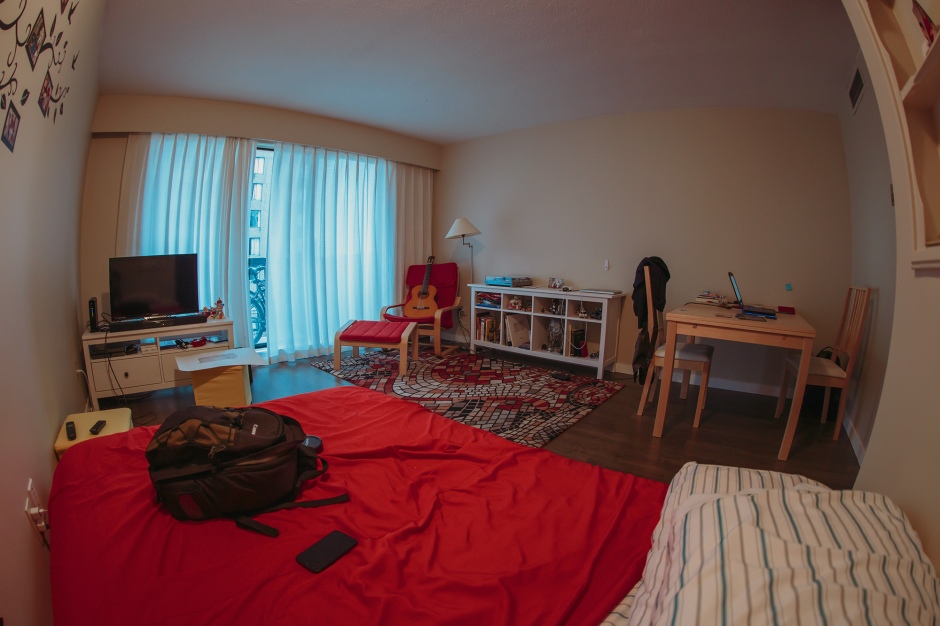Hoje eu comecei o dia com a perspectiva de uma única aula, à noite, das 19h às 22h, então, tudo para ser um dia super produtivo. Estranhamente, no meio de uma semana de pura neblina ao amanhecer e anoitecer, hoje o céu tava limpo e tivemos um nascer do Sol surrealmente bonito. Só vi as fotos aparecendo no feed do instagram e facebook. Antes disso, quando abri a cortina e vi que tava tudo limpo lá fora, fui correndo pegar a câmera pra fazer testes e (se tudo der certo) versões finais de coisas pro demo reel. Fiz umas costuras de fotos que somam 90mp e cada uma tem 500mb, para fazer camera projections – mais sobre isso nas próximas semanas. Ainda no clima de aproveitar esse tempo aberto, fiz cinco variações de HDRIs aqui no quarto (aqueles panoramas 360 graus, que a gente usa em 3D como mapa de reflexos e iluminação).
Com a câmera no tripé, parti direto pra garagem e fiz mais HDRIs e panoramas por lá. Não eram 9 da manhã e eu já tinha tirado 260 fotos – no total, essas todas foram convertidas em ONZE imagens, sem jogar nada fora. No processo de mesclar essas imagens, acho que aprendi todos os bugs do PTGui, e agora já tô indo mais rápido.
Dei uma geral na casa, lavei a louça, voltei a escrever no EOSHD e tô bem concentrado em fazer meu instagram ir pra frente. Acabei de perceber que nunca postei meu link aqui, então, lá atendo pelo nome de hovering lights. A estratégia é postar três fotos por dia, pelo menos, uma de manhã, sobre lentes, anamórficas, curiosidades, de tarde, algo mais livre e experimental, seja de técnica, seja de fotos que gosto mesmo, e de noite são séries com temas claros, alternadas. Até agora, são pouquíssimas fotos NOVAS por lá, tô reciclando um MOOONTE de coisa, afinal, quase dez anos de fotografia, alguma coisa tinha que prestar, né? Enfim, passando as filmagens do demo reel, nesse fim de semana, já tô combinando com a May de fazermos novas séries e idéias. Tenho que aumentar o público pra quando o demo reel estiver ficando pronto!
Fora essas coisas de computador, de Terça pra Quarta eu tive um sonho MUITO louco, que ainda tô considerando se posto aqui ou não – sério, era muito narrativo! – e quando sentei pra escrever, antes de ir pra aula, levei meia hora, sem parar, e quase me atrasei – que era uma das situações no sonho. No caminho, deixei o celular cair e acertei um mega chute no coitado que saiu escorregando na calçada. Fui correr pra pegar, deixei cair minhas luvas, voltei pra pegar, vi o ônibus passando (mais uma coisa que era bem presente no sonho) e saí correndo feito condenado pra alcançá-lo. No fim, nem me atrasei.
Terça eu reservei o estúdio de greenscreen da VFS, e um monte de equipamento de luz, e montei minha basezinha lá pra filmar com o Fernão umas coisinhas rápida pra usar no reel também. O Petar tava por lá e me ajudou a matar uns flares, posicionar luzes e foi um stand-in valioso. Com o Fernão, filmamos menos de dez minutos e já tinha material de excelente qualidade – amanhã posto um frame divertido. Depois, fizemos um photoscan rápido (ver meu instagram pra fotos disso) e depois desproduzimos tudo pra devolver.
Já que esse post tá totalmente aleatório, vou assumir a linguagem e cada parágrafo vai falar de algo (provavelmente) desconectado do anterior. Pelo lado bom, o título vai fazer sentido e vai dispensar qualquer título alternativo – que já tá virando tendência por aqui.
Terminei de traduzir o TCC, como vocês devem ter visto, e tenho recebido BASTANTE feedback legal, tá se provando um texto de grande valor agora que ele atingiu seu real objetivo: popularizar o conhecimento, de forma global. Já fiz novos contatos – em vários países – por conta dele, e o tema das anamórficas tá longe de morrer, o que é definitivamente positivo. O número de visitantes no blog por dia praticamente triplicou só por causa desse treco!
Ontem minha mãe ligou pra cá, pra skypearmos. Durante a conversa ela falou várias vezes que eu tava com uma cara diferente e tava parecendo bem mais animado. Me sinto mais animado mesmo, mas não achei que era tão fácil de perceber assim! Hoje, meu pai ligou. Conversamos sobre… programação! Algo que eu realmente não esperava, e de súbito, meu pai faz o mesmíssimo comentário de minha mãe “você tá mais animado aí, hein Tito?”. É, acho que eles me conhecem mesmo! HAHAHA!
No tempo livre durante a tarde, me atualizei com Person of Interest – faltava ver dois episódios, ambos incríveis – e assisti American Sniper, que não é um puuuuta filme, mas tem seus momentos – tem uma cena particularmente foda, que faz o filme todo valer. Aí foi chegando a hora de ir pra aula, tomei meu banho, vesti minhas 3240283 camadas de roupas e saí de casa. Quando chego na esquina, tentando abaixar o volume do celular, clico na mensagem de um colega, avisando que a aula foi cancelada. QUE SORTE QUE EU NÃO TINHA ENTRADO NO ÔNIBUS AINDA! Dei meia volta e cá estou, escrevendo esse post, criando coragem pra escrever mais um, em inglês, ou algum dos outros dois super-elaborados em português que estão fazendo aniversário nos rascunhos. Bom, esse aqui já deu o que tinha que dar.
AH! Um último comentário solto. Enquanto tava em Salvador, consertando o computador de Lila, com Lila – Madalena conseguiu jogar o notebook no chão – achei Worms Armageddon no Steam. Worms Armageddon é um clássico da minha infância, jogando HORAS E HORAS a fio com Sr. Pedro Alban e Leonardo Barreto. O jogo tem um modo single player com desafios e missões que a gente levou MESES pra completar. Resolvi comprar o jogo pra ter o que fazer durante o vôo de Salvador pra São Paulo. Nessa sentada, e mais duas aqui em Vancouver, consegui matar a porra toda. Eu lembrava de TODAS as missões e treinamentos. Ainda assim, foi muito divertido de jogar tudo de novo, sem ter que fazer mil gambiarras pro jogo funcionar no Windows 8 (como já tinha tentado e falhado miseravelmente no Win 7).
Menti, e tinha mais um parágrafo solto. Semana passada eu fui atrás de soluções práticas pra umas questões de luz do demo reel – e da casa também. Desde que peguei um abajur jogado no lixo, a iluminação da casa deu uma melhorada. O problema é que a tomada mais bem localizada do apartamento inteiro tava pifada desde que a gente se mudou. SEIS MESES morando aqui, e eu não tinha consertado essa maldita. Então, um dia de tarde eu passei na Dollarama, comprei um jogo de chaves e vim pra casa arrumar essa parada. Minha sorte: acho que comprei o ÚNICO jogo de chaves, na história do universo, incapaz de desparafusar qualquer coisa. Resultado, não consegui arrumar. No dia seguinte, aproveitei a tarde livre pra comprar OUTRO jogo de chaves (cada um foi $2, então o prejuízo é pequeno), e passar na Home Depot à procura de outros itens valiosos – alicate, fita isolante, voltímetro, um dimmer e uma lâmpada melhor pro abajur. Achei tudo, e gastei umas boas horinhas arrumando a fiação – tem um fio morto lá dentro, que não passa energia por nada no mundo – mas agora temos tomadas operantes, um abajur sucesso, com dimmer e tudo, e a casa vira um pouco mais nossa.
Agora sim, CHEGA.












You must be logged in to post a comment.